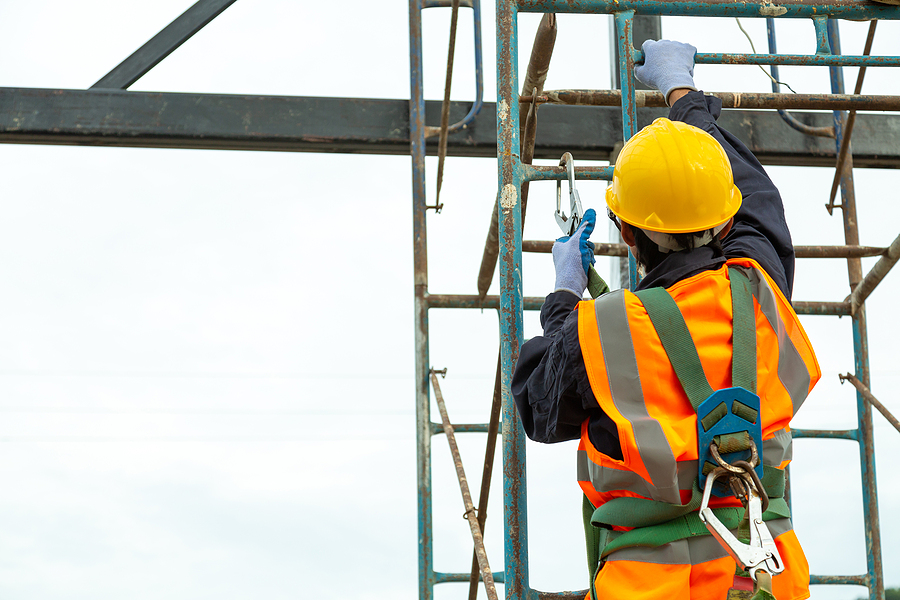Methods to Prevent Falls at Construction Sites

Companies need to fight falls at building sites. To stop them, we use “fall prevention”. It’s set up by construction industries. It stops workers’ falling accidents.
You might see guard rails. You’ll see scaffoldings too. These are prevention equipment. But, it’s not just equipment. There are also process controls. This means they train workers.
Another thing is “fall protection”. It controls the impact from falls. It comes into action if a fall happens. Workplace safety is important.
Construction firms provide special equipment. This gear helps workers. This gear is personal protective equipment (PPE). It can also be a fall arrest system. Examples? Hard hats and harnesses.
The OSHA sets the rules. They say we need fall protection gear. This gear is for workers who work high up. How high? Six feet above the ground or more. It’s also for workers at digging sites. How deep? Six feet or more.
Reasons Why Falls Happen
Let’s understand why falls happen. We need a good fall prevention plan. To make one, we need to know why falls happen. Why do they happen at building sites?
Faulty or deficient fall protection
One reason is faulty fall protection. This can mean bad harnesses. They might be worn out. There might be broken parts. Hooks or buckles could be bad. Guardrails might be made wrong. Scaffoldings too. Safety nets might be rigged badly. Sometimes, there’s no fall alert system. These all fall in this category.
Roofs undergoing construction
Another cause? Roofs being built. Falls might happen off unprotected edges. Falls might happen off unfinished parts. Even a worker’s mistake can cause a fall. It could be the person showing how to work.
Accidents due to aerial lifts
Aerial lifts cause accidents too. Many accidents happen with aerial lifts. Why? The lifts might be in a bad spot. This makes it wobble. So it might swing. This action can throw off the worker. We should avoid this. We should take steps to prevent all falls at construction sites. It will make the sites safer.
Unsafe Ladders
Unsafe ladders cause problems. They don’t meet safety standards. Sometimes, they don’t get inspected. These ladders can cause falls. Falls lead to injuries.
Slips, Trips, and Hazards
Clutter and debris are dangerous. They’re in high work areas. Workers step on objects. This makes them lose footing. They lose balance too. This causes falls.
How to Stop Falls on Sites
We can identify falls causes. We can prevent accidents. Accidents are not unpreventable. Want to stop falls? Check these ways for jobsites.
1. Do Risk Assessments Often
Do daily walk-throughs. It’s a best practice. Safety officers can do them. Other workers can too. Check for workplace hazards. Fix them right away.
Use an inspection checklist. It describes conditions of items. Which items? Guardrails, scaffoldings, and ladders. Also, fall arrest systems. Workers should inspect their gear. Do it every time they use it. These checks help. They find and stop risks. This can prevent accidents.
2. Give the Right, Safe Equipment
You must provide fall protection. It’s for your workers. Some have high-risk jobs. This protection is your duty. Don’t make workers pay for PPE. Roof workers need fall arrest systems. They need good harnesses. Install proper anchorage too.
The harness should fit well. Fit matters for weight and build. Make sure the gear follows safety rules. Ladders and scaffolds, too. Safety gears comply with requirements. Set ladders and scaffolds right. Place them on flat ground.
This adds stability. Add barriers in risky areas. It’s vital to prevent accidents. Mark floor holes too. Workers might fall into them. Use covers or protective devices.
3. Hire Right Workers
Construction workers have skills. Each skill is different. Construction managers think about time. They want to finish projects. But don’t switch jobs around. Don’t do it when someone’s absent. Don’t do it when there’s not enough workers. Choose the right person for heights. This person must handle the job well.
Taking unskilled workers is not smart. If they lack experience, it’s risky. Accidents might happen.
4. Train Workers Often
Workers need to know safety rules. They need to know them always. Here’s what you can teach:
- Teach about fall prevention. Share why it’s important.
- Workers need to operate equipment. Which equipment? Fall protection, ladders, and scaffolds.
- Teach them to find bad equipment. This means defective fall protection.
- Give safety rules for fixed ladders.
- Teach a special technique. It’s called “three-point contact”. Workers use three limbs. They use them to get on or off ladders. They use them for platforms too.
- Tell them about the buddy system. It’s very useful for roof workers.
- Select people for first-aid training.
- Establish an emergency response system.
After the training programs, assess workers. Check workers’ needs and performance. Ask for workers’ suggestions. They can propose new training areas. These should address problems. This way, we prevent dangers for workers.
5. Keep Jobsite Clean, Organized
Clean jobsites daily. Remove debris and hazards. They cause falls, slips, and trips. Remove dirt piles. Remove extra materials. Clear passageways. Store materials safely. Use areas with low traffic. Maybe an open yard. Keep floor areas dry. Avoid slippery surfaces. Maintain machinery often. Ensure it works well.
